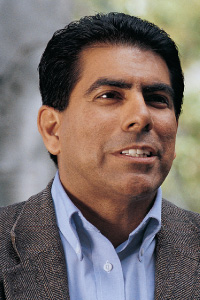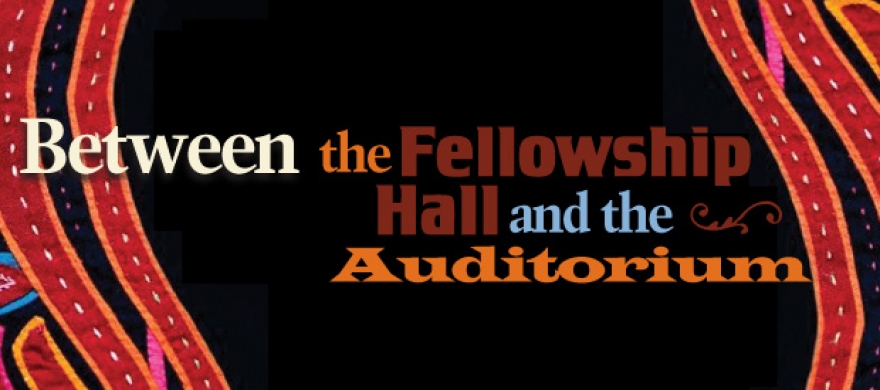Between the Fellowship Hall and the Auditorium
Professor Daniel Rodriguez discusses the future of the Latino church.
Daniel Rodriguez (’78, MA ’81), associate professor of religion and Hispanic studies, has noticed a worrying trend in Latino churches across America. While the Latino churches as a whole are growing, the younger, bilingual generations seem to be giving up on worship. Somewhere between a church’s fellowship hall, where the Spanish-speaking congregation will typically meet, and the auditorium, housing the English-speaking congregation, the children and grandchildren of Latino immigrants are getting lost.
In his latest book, A Future for the Latino Church: Models for Multilingual, Multigenerational Hispanic Congregations, Rodriguez makes the argument that Latino congregations need to be “sensitive to idiosyncratic differences between generations that are sometimes subtle, sometimes not so subtle.”
“The most obvious not so subtle difference is the use of language,” he asserts. First-generation immigrants will typically be Spanish-speaking, while “those who are second- generation might be bilingual, and third- and fourth-generation often are not at all. They’re strictly English-speaking.”
 While researching the initial idea for his book and taking a broad look at the mainline
protestant denominations, Rodriguez discovered time and again the misconception in
the Christian world that Latino churches should be Spanish-speaking by definition.
That might work for the “Abraham” generation, as he analogizes—the immigrant generation
who set the faith standard in their families. And it may even work for the bilingual
“Isaac” generation in the middle.
While researching the initial idea for his book and taking a broad look at the mainline
protestant denominations, Rodriguez discovered time and again the misconception in
the Christian world that Latino churches should be Spanish-speaking by definition.
That might work for the “Abraham” generation, as he analogizes—the immigrant generation
who set the faith standard in their families. And it may even work for the bilingual
“Isaac” generation in the middle.
But he found that the English-dominant third and fourth generations—the “Jacob” generations, about four percent of whom consider themselves bilingual, he says—might not want Spanish-language services, yet don’t necessarily feel comfortable or even fully welcome in English-language congregations. Rodriguez calls himself a Jacob: a third-generation Latino, with family hailing from Mexico.
“It seems intuitive to me that this generation of U.S.-born Latinos will need a different approach than we use with immigrants,” he notes, adding that he didn’t truly learn Spanish until long after he had finished his bachelor’s and master’s degrees in religion from Pepperdine and moved to Mexico as a missionary.
He ended up staying in Mexico for 10 years with his Midwestern, non-Latino wife Jeanette (’77), also a Pepperdine alumnus, and their four, fourth-generation children. While there, he evangelized and earned dual master’s degrees from La Universidad de las Americas in teaching English and Spanish as a second language.
As a result of this decade-long ministry, the entire family is fluent in Spanish. Initially, however, their adopted community in Mexico thought his strained Spanish was a joke at the expense of his non-Spanish-speaking American peers. “When they realized I wasn’t joking, it became something shameful,” he remembers. It’s vitally important, he adds, that families and churches reward efforts in communication between the Abraham and Jacob generations when trying to keep the family faith life intact.
“Some of the fastest growing multicultural churches are Hispanic churches that are slowly becoming multicultural, because the Hispanic experience for the U.S.- born is multicultural. Our churches will have to start looking like our families,” he explains. “Where that culture exists of being multilingual, multigenerational, churches are thriving.”
His culturally altering experiences in Mexico helped Rodriguez form hypotheses about Latino churches in America, which he developed on a four-year research and spiritual pilgrimage to approximately 45 thriving congregations around the country. He wanted to visit those thriving multilingual, multigenerational churches to discover what they were doing right.
He was struck by the fact that the churches thriving across the generations were not simply addressing a language barrier; the divide between the Abrahams and the Jacobs goes deeper and involves cultural differences between the generations. For example, the growing churches made use of the Internet to advertise their body of worship. He explains, “Very few of the immigrant churches had websites, because a lot of the immigrants just don’t surf the web like that. But U.S.-born Hispanics don’t do anything without checking the web first when they’re looking for something.”
One church in Chicago stood out to him as an “amazing” example and blueprint of what he found to be the best method of ebbing the flow of second- and third- generation absenteeism. The method is simple: maintain the church’s message through three or more simultaneous services—one traditional Spanish service for the older family members or new immigrants, one traditional English service for the bilingual middle generation, and a more contemporary service for the younger generations. Using this model, the church in Chicago grew in 10 years from 125 to 6,000 members and attracts people from all walks of life, becoming truly multigenerational, multilingual, and multiethnic.
Rodriguez stresses that immigrant churches will always play an important role in helping new arrivals find community—and maybe find Christ if they haven’t yet done so. He also points out that he named the book A Future for the Latino Church instead of The Future for the Latino Church specifically because this is the future he hopes to see unfold, but it is by no means the only possible future for Latino churches. His hopes are raised by the positive responses to his book from Latino church leaders across the country who have thanked him for addressing the “hemorrhaging of second- and third-generation Christians leaving the church.”
Ultimately, Rodriguez doesn’t prescribe spiritual medicine to Latino churches to cure fractured congregations, but instead hopes to inspire through the achievements of congregations that are successfully bridging the generational divide.
“My hope is that the leaders who read my book can keep their churches intact so that the grandma who doesn’t speak any English, her grandson who doesn’t speak any Spanish, and the father and mother who are bilingual can all fit under the same roof,” he says.
